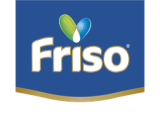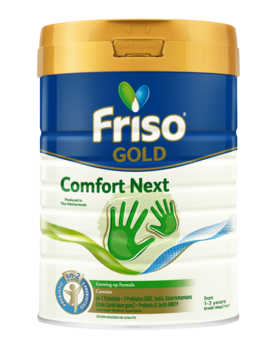Friso Gold® Comfort Next
for toddlers aged 1-3 years old
Contains:
Probiotic
Probiotics are beneficial bacteria that helps in digestion. Friso Gold® Comfort Next contains the probiotic Bifidobacterium lactis HN019.
3 Prebiotics
Friso Gold® Comfort Next has a unique mix of 3 prebiotics consisting of Galacto-oligosaccharides (GOS), Inulin, and Galactomannans from Carob Bean Gum (CBG). Prebiotics promotes the growth of good Bifidus bacteria to help maintain a healthy digestive system.
sn-2 Palmitate
Natural sn-2 palmitate* from milk fat.
Buy now

Dietary changes and lifestyle factors affect the digestive health of adults and children alike. Friso recommends a holistic approach to the management of constipation in children. Formulated as part of a varied diet, Friso Gold® Comfort Next is designed to provide nutritional support for the management of constipation in children aged 1 year onwards. It contains probiotic, 3 prebiotics and natural sn-2 palmitate* from milk fat.
How to prepare Friso Gold® Comfort Next
My child’s pediatrician just prescribed him Friso Gold® Comfort Next. How do I prepare Friso Gold® Comfort Next?
 |
Use enclosed scoop to add 1 levelled scoop to each 30ml of water, up to a total of 6 scoops. |
 |
Pour 180 ml of lukewarm water (40°C) into the feeding bottle. |
 |
Twirl bottle until the powder is completely dissolved. |
Complete nutrition info
Energy
Dietary Fibre
Minerals
Vitamins
Nucleotides
| Description | Unit | Per 100g | Per 100ml |
|---|---|---|---|
| Energy | kcal | 469 | 62 |
| kJ | 1967 | 260 | |
| Protein | g | 14.9 | 2 |
| Total Fat | g | 21.7 | 2.9 |
| -Saturated Fat | g | 9.2 | 1.2 |
| -sn-2 Palmitate | g | 1 | 0.1 |
| -Linoleic Acid | mg | 2360 | 311.5 |
| -α-linolenic acid | mg | 310 | 40.9 |
| -Docosahexaenoic acid (DHA) | mg | 49 | 6.5 |
| Carbohydrates | g | 51.6 | 6.8 |
| -Total Sugars | g | 49 | 6.5 |
| --Lactose | g | 48 | 6.3 |
| --Added Sugar | g | 1 | 0.1 |
| Description | Unit | Per 100g | Per 100ml |
|---|---|---|---|
| Dietary Fibre | g | 2 | 0.3 |
| -Galacto-oligosaccharides (GOS) | g | 0.7 | 0.1 |
| -Galactomannans (from Carob bean gum) | g | 0.5 | 0.1 |
| -Inulin | g | 0.8 | 0.1 |
| Description | Unit | Per 100g | Per 100ml |
|---|---|---|---|
| Calcium | mg | 535 | 70.6 |
| Phosphorus | mg | 420 | 55.4 |
| Sodium | mg | 225 | 30 |
| Potassium | mg | 536 | 70.8 |
| Chloride | mg | 312 | 41.2 |
| Magnesium | mg | 60 | 7.9 |
| Iron | mg | 5.8 | 0.8 |
| Iodine | µg | 124 | 16.4 |
| Zinc | mg | 3.8 | 0.5 |
| Copper | µg | 332 | 43.8 |
| Manganese | µg | 200 | 26.4 |
| Selenium | µg | 19.2 | 2.5 |
| Description | Unit | Per 100g | Per 100ml |
|---|---|---|---|
| Vitamin A | µg-RE | 456 | 60.2 |
| Vitamin D3 | µg | 6.9 | 0.9 |
| Vitamin C | mg | 120 | 15.8 |
| Vitamin B1 | µg | 524 | 69.2 |
| Vitamin B2 | µg | 720 | 95 |
| Niacin | mg | 3.2 | 0.4 |
| Vitamin B6 | µg | 560 | 73.9 |
| Folic Acid | µg | 156 | 20.6 |
| Pantothenic Acid | mg | 3.1 | 0.4 |
| Vitamin B12 | µg | 1.3 | 0.2 |
| Vitamin K1 | µg | 36 | 4.8 |
| Biotin | µg | 20 | 2.6 |
| Vitamin E | mg α-TE | 6.4 | 0.8 |
| Description | Unit | Per 100g | Per 100ml |
|---|---|---|---|
| Nucleotides | mg | 32.1 | 4.2 |
| Choline | mg | 112 | 14.8 |
| Taurine | mg | 31.2 | 4.1 |
| Inositol | mg | 21.6 | 2.9 |
| L-Carnitine | mg | 13.6 | 1.8 |
Other questions you may have
What is the difference between Friso Gold® Comfort Next and Friso Gold® Stage 3?
Although both products are indicated and nutritionally designed for children of age 1 year and above, Friso Gold® Stage 3 is indicated for healthy children in general whereas Friso Gold® Comfort Next is specially formulated to provide nutritional support for the dietary management of constipation in children aged 1 year onwards.
How many servings of Friso Gold® Comfort Next can I give to my child per day?
You can give 2-3 servings of Friso Gold® Comfort Next per day as stated on the tin.
Friso Gold® Stage 3 has no added sucrose. How about Friso Gold® Comfort Next?
Yes, Friso Gold® Stage 3 does not contain added sucrose. Likewise, Friso Gold® Comfort Next doesn’t contain added sucrose.
*From milk fat
^Manios Y, Karaglani E, Thijs-Verhoeven I, et al. ‘Effect of milk fat-based infant formulae on stool fatty acid soaps and calcium excretion in healthy term infants: two double-blind randomized cross-over trials’. BMC Nutrition. 2020; 6:46.
1. Watson D, O’Connell Motherway M, Schoterman MHC, van Neerven RJJ, Nauta A, Van Sinderen D. ‘Selective carbohydrate utilization by lactobacilli and bifidobacteria’. J Appl Microbiol. 2013;114(4):1132-1146.
2. Ben X-M, Li J, Feng Z-T, et al. ‘Low level of galacto-oligosaccharide in infant formula stimulates growth of intestinal Bifidobacteria and Lactobacilli’. World J Gastroenterol. 2008;14(42):6564.
3. Moro G, Minoli I, Mosca M, et al. ‘Dosage-related bifidogenic effects of galacto- and fructooligosaccharides in formula-fed term infants’. J Pediatr Gastroenterol Nutr. 2002;34(3):291-295.
4. Gonzalez-Bermudez CA, Lopez-Nicolas R, Peso-Echarri P, Frontela-Saseta C, Martinez-Gracia C. ‘Effects of different thickening agents on Infant gut microbiota’. Food Funct. 2018. 9(3):1768–1778.
5. Sprong C, Snel H, Schonewille A. Effect of Slowly Fermentable Prebiotics on Resistance to Eneropathogenic Infections. Vol 011. Ed: 2005.
6. Tounian P, Meunier L, Speijers G, Oozeer R, Vandenplas Y. ‘Effectiveness and Tolerance of a Locust Bean Gum-Thickened Formula: A Real-Life Study’. Pediatric Gastroenterology, Hepatology and Nutrition. 2020 Nov; 23(6):511-520.
7. Petit V, Sandoz L, Garcia-Rodenas CL. ‘Importance of the regiospecific distribution of long-chain saturated fatty acids on gut comfort, fat and calcium absorption in infants’. Prostaglandins Leukot Essent Fatty Acids. 2017;121:40-51.
8. Innis SM. ‘Dietary triacylglycerol structure and its role in infant nutrition’. Adv Nutr. 2011;2(3):275-283.
9. Litmanovitz I, Bar-Yoseph F, Lifshitz Y, et al. ‘Reduced crying in term infants fed high beta-palmitate formula: a double-blind randomized clinical trial’. BMC Pediatr. 2014;14(1):152.
10. Straarup EM, Lauritzen L, Faerk J, Høy CE, Michaelsen KF. ‘The stereospecific triacylglycerol structures and fatty acid profiles of human milk and infant formulas‘. Journal of Pediatric Gastroenterology and Nutrition. 2006;42(3):293-9.




